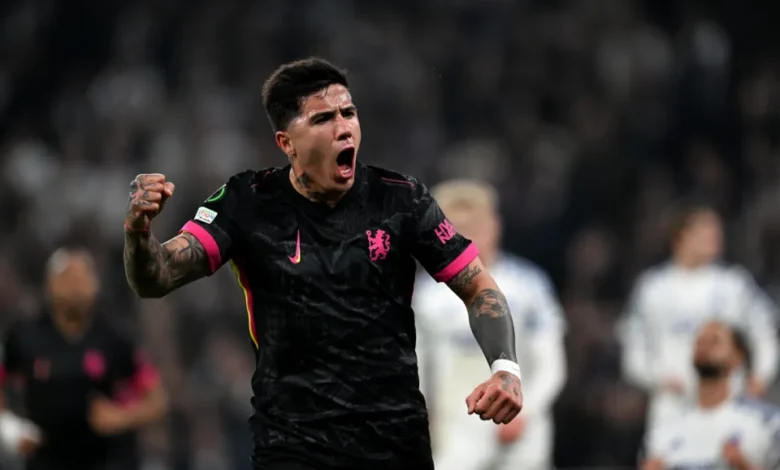
Chelsea have had a difficult time since the turn of the year, struggling for consistency and results. However, in the past few weeks, they have managed to string together three consecutive wins, offering hope of a turnaround.
A 4-0 victory over Southampton in the FA Cup, followed by a 1-2 away win against Copenhagen in the UEFA Conference League, and a narrow 1-0 triumph over Leicester City have given Enzo Maresca’s side much-needed momentum.
Despite this, issues still linger around Stamford Bridge. The atmosphere remains tense, with fans growing frustrated over Chelsea’s performances and the so-called “boring football” under Maresca. While results have improved, the team still faces criticism for lacking attacking fluidity and dominance.
With a place in the Conference League quarter-finals at stake, Chelsea must deliver a strong performance at home to avoid any unnecessary drama.
So, how did the first leg against Copenhagen play out? What did Chelsea get right, and where do they need to improve to ensure qualification? Here is the Chelsea vs Copenhagen Tactical Preview.
Chelsea vs Copenhagen Tactical Preview
Enzo Maresca made several changes to his lineup, opting for a 4-2-3-1 formation with Reece James and Moisés Caicedo in midfield. Malo Gusto provided width at left-back, while George occupied the right flank. Cole Palmer and Kiernan Dewsbury-Hall (KDH) operated in the half-spaces, with Josh Mheuka leading the line.

In possession, Chelsea shifted into a 3-2-5 shape, with Trevoh Chalobah inverting from right-back to form a back three alongside Tosin Adarabioyo and Benoît Badiashile. James and Caicedo controlled the midfield pivot, while Gusto, KDH, Mheuka, Palmer, and George made up the attacking front line.
Copenhagen’s Tactical Surprise in the Conference League Clash
Copenhagen manager Jacob Neestrup surprised Chelsea by switching to a back five, deviating from their usual back four. Notably, they deployed two right-backs, with Diks (normally a center-back) playing wide and Giorgi Gocholeishvili dropping deep to reinforce the defensive line.
This tactical adjustment effectively disrupted Chelsea’s attacking rhythm, as Maresca’s side has struggled against compact back-five setups in the past.

Chelsea vs Copenhagen was expected to feature an aggressive press from the Danish side, but they remained disciplined in a mid-block, refusing to engage high up the pitch. When Palmer or KDH dropped deep to receive possession, Copenhagen’s defenders tracked them tightly, triggering selective pressing moments. However, when Chelsea attempted to bait the press with back passes, Copenhagen remained compact instead of pressing aggressively.
Copenhagen’s Attacking Strategy
On the ball, Copenhagen mirrored Chelsea’s 3-2-5 shape, with wing-backs pushing wide and wingers tucking into half-spaces. Their key attacking strategies involved:
- Finding wingers in the half-spaces through wing-back deliveries.
- Exploiting Chelsea’s high defensive line with direct balls in behind.
Despite these efforts, Copenhagen rarely troubled Chelsea’s defense, struggling to create clear-cut opportunities.
Chelsea’s Pressing Issues and Attacking Struggles
Chelsea vs Copenhagen saw Maresca’s side pressing in a 4-2-4 structure, with Palmer and Mheuka leading the press by curving their runs to block passing lanes. This forced Copenhagen’s defenders to one side, limiting their passing options and often leading to long clearances.

However, Chelsea struggled in attack. Despite reaching the final third regularly, their decision-making and execution lacked precision. Copenhagen tracked runs effectively and maintained their defensive structure, limiting Chelsea’s ability to create meaningful chances.
Even when crossing opportunities presented themselves, Chelsea hesitated, possibly due to the absence of a true aerial presence in the box.
Second-Half Adjustments and Key Moments
Recognizing Chelsea’s lack of attacking penetration, Maresca made crucial halftime substitutions, introducing Enzo Fernández, Christopher Nkunku, and Levi Colwill. These changes altered the tactical setup:
- George moved into a false nine role.
- Nkunku played on the left, cutting inside.
- Enzo replaced Caicedo in midfield alongside James.
- KDH shifted to the right wing.
Chelsea immediately benefited from these changes, scoring right after the restart. James, now operating centrally, showcased his long-range shooting ability, a crucial but often underutilized weapon in Chelsea’s squad.
Copenhagen responded by increasing their pressing intensity and nearly equalized after exposing Chelsea’s high defensive line. James, in particular, was caught out on one crucial run in behind.
Despite this, Chelsea’s pressing intensity improved in the second half, transitioning into a full man-to-man setup. By forcing Copenhagen towards their right side (Chelsea’s left), Nkunku and Marc Cucurella effectively trapped them, regained possession, and Chelsea converted the opportunity into a goal.
Final Thoughts Ahead of the Second Leg
Copenhagen pulled one back through a poorly defended set piece, but overall, Chelsea vs Copenhagen lacked high-quality chances, with both teams generating an xG below 0.40. Chelsea got the win but would have preferred a two-goal cushion heading into the second leg of this UEFA Conference League tie.
As Chelsea prepare for the return fixture, Maresca’s men must refine their attacking approach and remain defensively disciplined. Copenhagen’s tactical flexibility has already troubled them once, and another rigid defensive setup could make the second leg just as challenging. A sharper performance in possession and better execution in the final third will be crucial if Chelsea are to progress comfortably in the Conference League.




